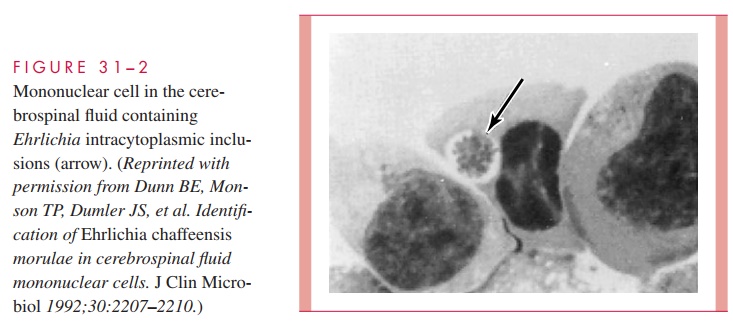Chapter: Medical Microbiology: An Introduction to Infectious Diseases: Rickettsia, Coxiella, Ehrlichia, and Bartonella
Ehrlichia
EHRLICHIA
The Ehrlichia genus includes several species of white blood cell (WBC)–associated bacteria that cause human disease. Ehrlichia sennetsu, the first species to be identified as a cause of human disease, is restricted to Japan and Malaysia. In the United States, two species are the principal causes of two diseases: (1) human monocytic ehrlichiosis (HME), which is due to Ehrlichia chaffeensis; and human granulocytic ehrlichiosis (HGE), which is due to Anaplasma phagocytophilum. E. chaffeensis infections tend to occur in the southeasternand lower midwestern United States, whereas the other infections tend to cluster in the northern states, with a distribution similar to Lyme disease . They were first reported to cause human disease in the 1950s. HGE is the predominant form of ehrli-chiosis and is second only to Lyme disease as a tickborne infection in the United States. They are transmitted by deer or dog ticks. Both HME and HGE are clinically similar to RMSF, but rashes are less commonly seen. Still another species, E. ewingii, causes dog ehrlichiosis, which is occasionally contracted by humans.
On occasion, the diagnosis of ehrlichiosis may be suggested by observation of charac-teristic ehrlichial intracytoplasmic inclusions (morulae) in granulocytes (HGE) or mononuclear cells (HME) (Fig 31–2). Confirmation is usually made serologically by a fourfold or greater rise in IFA antibody or a titer greater than or equal to 1:64 to the specific antigen. These tests require the assistance of specialized laboratories. Another diagnostic test for detection of ehrlichia DNA is the polymerase chain reaction (PCR). Laboratory clues to human ehrlichiosis include a falling leukocyte count, thrombocytope-nia, anemia, and impaired liver and renal function.
Doxycycline is the drug of choice for ehrlichiosis. The risk of infection can be reduced by avoiding wooded areas and tick bites.

Related Topics